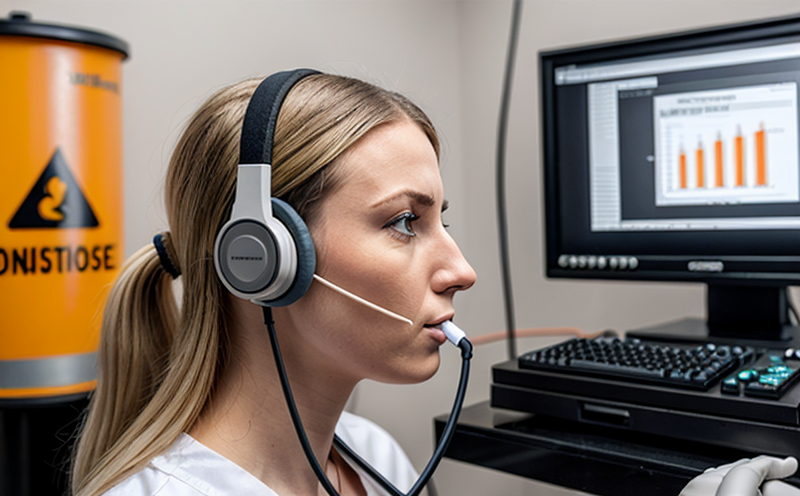EN 61672-3 Acoustic Performance of Noise Measurement Instruments
The EN 61672-3 standard is a pivotal document for ensuring the accuracy and reliability of noise measurement instruments used in occupational health, environmental monitoring, and industrial settings. This standard specifically addresses the acoustic performance requirements that are crucial for accurate noise measurements, which can directly impact worker safety, regulatory compliance, and overall productivity.
In occupational environments, noise exposure is a significant risk factor leading to hearing loss among workers. Properly calibrated and reliable noise measurement instruments play a critical role in assessing this hazard. The EN 61672-3 standard ensures that these instruments provide accurate measurements, which are essential for effective monitoring, control measures, and regulatory compliance.
The standard covers a wide range of parameters including frequency response, sensitivity, signal-to-noise ratio, and other performance characteristics relevant to noise measurement. Compliance with this standard is mandatory in many countries as part of occupational health and safety regulations. It also supports the development of new instruments that meet stringent accuracy requirements, ensuring trustworthiness and reliability.
The acoustic performance parameters defined by EN 61672-3 are critical for various applications such as:
- Occupational noise exposure assessment
- Evaluation of hearing protection devices
- Environmental noise monitoring
- Industrial machinery testing
- Audio equipment validation
In summary, the EN 61672-3 standard is not just a technical requirement but also a cornerstone of occupational health and safety. Its implementation ensures that noise measurement instruments are reliable, accurate, and meet international standards, thereby protecting workers' hearing and supporting regulatory compliance.
Scope and Methodology
| Parameter | Description |
|---|---|
| Frequency Response | The standard specifies the required frequency response of noise measurement instruments to ensure accurate measurements across a wide range of frequencies. |
| Sensitivity | This parameter ensures that the instrument can accurately measure even very low levels of sound, crucial for assessing occupational noise exposure. |
| Signal-to-Noise Ratio | The ratio is defined to ensure that any background noise does not interfere with accurate measurement results. |
| Cross-Sensitivity | This parameter assesses the instrument's ability to avoid interference from other environmental factors, ensuring reliable measurements. |
The methodology for testing these instruments is rigorous and involves:
- Calibration of the instrument against known sound levels.
- Measurement under controlled conditions to ensure consistency.
- Evaluation of various parameters such as frequency response, sensitivity, and signal-to-noise ratio.
- Validation using real-world scenarios where instruments are used in occupational settings.
The results of these tests are then compiled into detailed reports that can be used by quality managers and compliance officers to ensure their instruments meet the necessary standards. This ensures that any noise measurement instruments used comply with international best practices, thereby enhancing occupational safety and regulatory compliance.
Why Choose This Test
- Regulatory Compliance: Ensures that your noise measurement instruments meet strict international standards required for occupational health and safety.
- Accuracy: Provides accurate measurements across a wide range of frequencies, ensuring reliable data collection.
- Safety: Protects workers from overexposure to harmful noise levels by providing trustworthy instrument readings.
- Consistency: Ensures that the instruments consistently provide accurate results under various conditions, enhancing reliability.
- Validation: Validates new instruments against industry standards, ensuring they meet performance criteria before release.
By choosing this test, you ensure that your noise measurement instruments are not only compliant with international standards but also reliable and consistent. This is crucial for maintaining a safe work environment and meeting regulatory requirements in various industries.
Competitive Advantage and Market Impact
- Enhanced Reputation: Compliance with this standard enhances your company's reputation as a leader in occupational health and safety, attracting more customers.
- Increased Customer Trust: By ensuring accurate noise measurement, you build trust with clients who rely on precise data for decision-making.
- Competitive Edge: Meeting international standards positions your company ahead of competitors who may not adhere to such rigorous testing protocols.
- Market Differentiation: Your instruments are recognized as superior quality, leading to a competitive advantage in the market.
The use of accurate noise measurement instruments can have far-reaching effects on the industry. By ensuring that your products and services meet these stringent standards, you contribute to safer workplaces and healthier environments. This not only benefits individual organizations but also has a positive impact on society as a whole.
In conclusion, choosing this test is not just about meeting regulatory requirements; it's about setting a new benchmark for excellence in occupational health and safety. It ensures that your noise measurement instruments are among the most accurate and reliable available, providing you with a significant competitive edge in the market.





